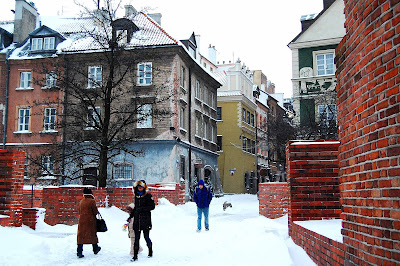On Sunday I shall be going to the ballot box to cast my vote in the local elections. Voting for Poland's president, one is voting for how our country will be perceived abroad. It also gives you the chance to determine whether the ruling parliamentary majority needs a veto-wielding counterbalance. Parliamentary elections are more important. Poles may moan about our current 'do little' government, but just think of the alternatives from not that long ago - a coalition that included LPR and Samoobrona, or a post-communist government rotten to its very core.
But local authority elections in Poland, though not accorded the same degree of media coverage as the presidential and parliamentary ones are also important, and, I think, not clearly understood. I've spoken to many Poles about the mechanism of Sunday's elections, but no one has been able to tell me precisely what local government positions we will be voting for.
The Polish National Electoral Committee (PKW) has an
excellent website with
pages in English too, setting out the facts and figures behind Sunday's local government (or as they have it here, 'self-government') elections. Mazowieckie province, which includes Warsaw, is home to over five million Poles, of whom over four million are eligible to vote. Mazowieckie is one of 16 Polish
voivodships (provinces). Each one is run by a voivode (
wojewoda or governor) appointed by the Prime Minister, and a chief executive (
marszałek or marshal) elected by members of the provincial parliament (
sejmik) who themselves will be directly elected by popular vote this Sunday.
Here in Jeziorki, we will be voting for the mayor of Warsaw (
prezydent miasta) and for councillors (
radni) for Ursynów district (
dzielnica - one of 18 that make up the capital). And for the provincial self-government (
sejmik) of Mazowieckie. The provincial 'little parliament' is elected by inhabitants of Mazowsze's 37
powiats.
So who will I be voting for on Sunday? Well, I had my rant a few weeks ago about the lack of pavements and drains in Jeziorki. Since then, we've been informed that the drains are on the way (maybe in two years time, says one neighbour). Another neighbour tells me that people living on ul. Karczunkowska have been informed that a pavement is due, and that plots running up to the asphalt will have a strip of land compulsorily purchased so that paving slabs can at last be laid. Eventually. So then - the Warsaw mayoral race is between Hanna Gronkiewicz-Waltz (Civic Platform), Ciesław Bielecki (Law and Justice) and Wojciech Olejniczak (Democratic Left Alliance). The latest polls (published on Monday) put Gronkiewicz-Waltz on 50%, Bielecki on 20% and Olejniczak on 13%. Three other candidates including my protest-vote pick, Katarzyna Munio, are on 1%.
It is worth noting that whereas not a single national government has ever been re-elected in Poland since democracy was restored in 1989, local authorities - in particular popular mayors - routinely get re-elected for successive terms. Three-term mayors are not a rarity. This leads to continuity in local government affairs; a good
gospodarz (host, householder) delivers the infrastructure, wins respect and popularity by doing so and gets re-elected again and again. In its annual survey of foreign investors in Poland, the state inward investment agency PAIiIZ finds year after year that multinationals setting up in Poland rate the quality of local government as being superior to that of central government. My guess is that it's for this very reason; continuity.
Moving on the the district council election, my children and I have dreamed up a fantastical conceit of how
Nasz Ursynów, a local electoral initiative, might turn out in practice. Though its hyper-active website reveals little, our joke is that this party is not so much
ultra-nationalist as
ultra-localist. Their demands will no doubt insist than non-Ursynauers who cannot a prove a pure Ursynite bloodline be sent back to the Żoliborzes, Mokotóws or Saska Kępas from whence they came; that the gyppos camping out amid Jeziorki boglands in their squalid detached houses be kept out of Ursynów proper by a ghetto-style wall running along the east side of ul. Puławska, and that armed guards inspect passengers' residence permits on the Metro between Służew and Ursynów, turning away anyone who cannot offer proof of being an Ursynauer. Torchlight parades down al. KEN, bricks thrown through windows of shops owned by Radomites or (heavens forfend) even people from
outside Mazowsze province and the impounding of all cars not on WN plates (starting with those wretches with WPIs).
Fantastical conceits notwithstanding, I'm not convinced by Nasz Ursynów's arguments, and will despite everything, in the end be voting once again for Civic Platform. Resignedly.
 The Bristol looks quite splendid lit up at night amid all the snow, as indeed does the entrance to the University of Warsaw (below).
The Bristol looks quite splendid lit up at night amid all the snow, as indeed does the entrance to the University of Warsaw (below). The Smolensk cross, that had been such a socially divisive issue for 154 days this year, has gone. Not a sign of it remains. There are no elderly protesters outside the presidential palace next door to the Bristol, handing out leaflets written in deranged tones about conspiracy and murder and Jews. A place once full of anger and discord is now at peace, blanketed by snow and illuminated by Christmas lights.
The Smolensk cross, that had been such a socially divisive issue for 154 days this year, has gone. Not a sign of it remains. There are no elderly protesters outside the presidential palace next door to the Bristol, handing out leaflets written in deranged tones about conspiracy and murder and Jews. A place once full of anger and discord is now at peace, blanketed by snow and illuminated by Christmas lights.




















































